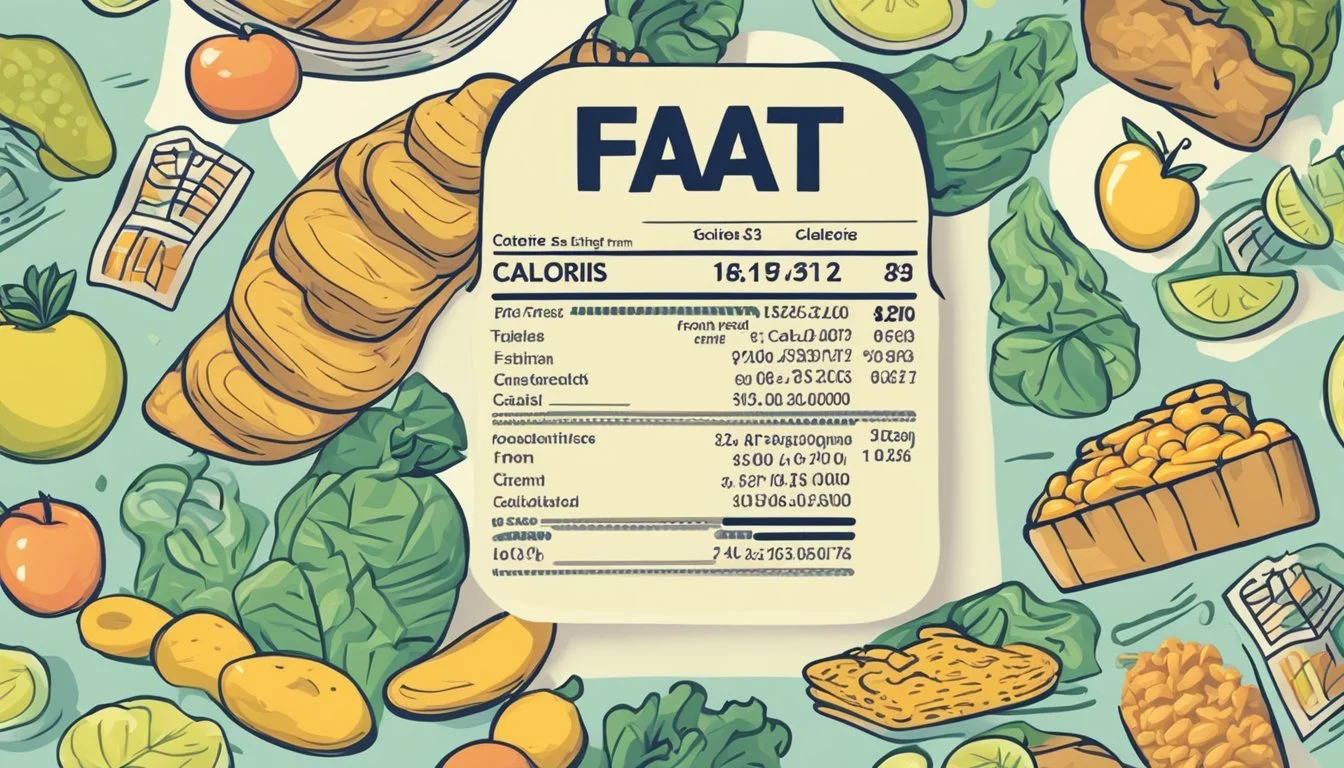The Myth of Calories from Fat
Debunking Weight Gain Misconceptions
In discussing diet and nutrition, the concept of "calories from fat" has often been a source of confusion. The common belief is that these calories are more fattening than calories derived from other macronutrients such as carbohydrates and proteins. A calorie is a unit of energy, and all calories have the same energy content regardless of the source. However, the body's metabolic pathways process these macronutrients differently, which can affect how easily they are stored as fat.
The nutritional value of food involves more than just its caloric content. While fats are energy-dense, providing 9 calories per gram compared to 4 calories per gram for both carbohydrates and proteins, the type of fat consumed plays a critical role in health. For instance, diets rich in polyunsaturated and monounsaturated fats are linked to better heart health compared to diets high in saturated fats. Balancing caloric intake with expenditure is key in maintaining a healthy weight, rather than focusing solely on the percentage of calories coming from fat.
Changing dietary guidelines reflect new understanding; nutrition labels no longer emphasize calories from fat. This shift arises from studies suggesting that the quality of the diet, along with lifestyle and genetics, influences health outcomes more than the quantity of fat alone. It's essential to consider the whole nutritional profile—including vitamins, minerals, and fiber—of foods when constructing a diet, recognizing that a balanced approach supports better health rather than fixating on one nutrient.
Understanding Calories and Dietary Fats
In this section, we dissect the interplay between calories and dietary fats, focusing on how different types of fats impact overall calorie intake and health.
The Nature of Calories
Calories are units of energy that measure the amount of energy food provides to the body. The body requires a certain number of calories each day to perform basic functions and additional activity. Excessive intake of calories, regardless of the source, can lead to weight gain.
Different Types of Dietary Fats
Dietary fats are a macronutrient group that can be divided into several types:
Saturated fats: Typically solid at room temperature, found in animal products and some tropical oils. Excessive consumption may raise LDL cholesterol levels.
Trans fats: Industrially produced fats present in some processed foods. They are associated with an increased risk of heart disease.
Monounsaturated fats (MUFAs): Found in olive oil, avocados, and nuts, these can support heart health when eaten in moderation.
Polyunsaturated fats (PUFAs): Includes omega-3 and omega-6 fatty acids found in fish, flaxseeds, and walnuts, essential for bodily functions.
Calories from Fat vs. Other Macronutrients
Calories from fat are denser, providing 9 calories per gram, compared to 4 calories per gram from proteins and carbohydrates. It's the excessive caloric intake, rather than the presence of fat alone, that contributes to weight gain.
Proteins: Essential for tissue repair and enzymes, contain 4 calories per gram.
Carbohydrates: The body's primary energy source, also contain 4 calories per gram.
Fats: Despite having more calories, fats are necessary for nutrient absorption, hormone production, and cell health.
Nutritional Aspects of Fats
Fats play a crucial role in maintaining health, but it is important to make a distinction between the different types of fats and the unique impact each one has on the body.
Role of Fats in the Body
Fats, also known as lipids, serve several critical functions. They are essential for storing energy, protecting vital organs, and aiding in the absorption of fat-soluble vitamins such as Vitamin A, D, E, and K. Fatty acids, the building blocks of fats, are necessary for producing cell membranes and certain hormones. Furthermore, fats provide insulation to help maintain body temperature and serve as a source of essential fatty acids that the body cannot synthesize on its own. Healthy fats, such as those found in nuts and fish, contribute to these physiological processes without compromising cardiovascular health.
Impact of Different Fats on Health
The impact of fats on health largely depends on the type consumed. Saturated fats and trans fats tend to raise LDL cholesterol (or "bad" cholesterol) levels in the blood, potentially increasing the risk of heart disease and cardiovascular disease. On the other hand, unsaturated fats, which include mono- and polyunsaturated fats, are known to reduce LDL cholesterol and overall cholesterol levels, thereby diminishing the risk of heart-related health issues. Monounsaturated fats, particularly prevalent in olive oil and avocados, and polyunsaturated fats present in walnuts and fatty fish like salmon, help improve heart health. It is generally recommended that fat intake should be moderated and should prioritize healthy fats to maintain optimal health and reduce the risk of chronic diseases.
Fat Consumption and Health Outcomes
The impact of dietary fats on health is multifaceted, influencing weight management and the risk of various chronic diseases, including heart disease. It is crucial to understand how different types of fat relate to these health outcomes.
Fats and Heart Disease
Dietary fats have a significant influence on heart health. Saturated fats can raise LDL cholesterol levels, contributing to an increased risk of heart disease and stroke. The American Heart Association recommends limiting saturated fat to reduce this risk. Conversely, unsaturated fats, especially those from fish, nuts, and olive oil, can have a protective effect by improving lipid profiles, including reducing LDL cholesterol and increasing HDL cholesterol.
Fats and Weight Management
Despite the common belief, calories from fat are not inherently more fattening than calories from other macronutrients. However, fats are more calorie-dense, with 9 calories per gram, which can contribute to weight gain if consumed in excess. The focus should be on the quality of fat and maintaining overall caloric balance. Consuming healthy fats in moderation is a key aspect of weight management and can help prevent obesity, a risk factor for chronic diseases.
Fats and Chronic Diseases
Fats play a notable role in the development of chronic diseases such as diabetes, obesity, and high blood pressure. Trans fats, often found in processed foods, are particularly harmful as they contribute to dyslipidemia - an abnormal amount of lipids in the blood - and exacerbate chronic disease risks. Both the World Health Organization and the American Heart Association advocate for the reduction of trans fats in the diet to decrease the likelihood of these conditions.
Dietary Recommendations and Guidelines
Understanding the impact of caloric intake from fats on overall health is critical. Dietary guidelines offer a blueprint for proportioning macro-nutrient consumption, especially with regard to fats.
Fat Intake Guidelines
World Health Organization (WHO) and American Heart Association (AHA) recommend that total fat should provide between 20-35% of a person's total daily calories. Notably, WHO suggests that for individuals maintaining their weight, the upper limit for fat consumption could be less strictly adhered to, implying that some may consume up to 40% of their calories from fat if balanced by overall calorie intake to maintain energy equilibrium. On the other hand, the British Heart Foundation and Joint British Societies endorse a slightly more conservative outlook, emphasizing the importance of limiting saturated fat to reduce heart disease risk.
Saturated Fats: Less than 7% of total daily calorie intake
Trans Fats: As low as possible
Polyunsaturated Fats (PUFAs): Up to 11% of daily calories
Monounsaturated Fats (MUFAs): Up to 20% of daily calories
Caloric Balance for Optimal Health
Maintaining a state of caloric balance is a cornerstone for optimal health. This entails aligning energy consumed from all macro-nutrients, including fats, with the energy expended through physical activity and metabolic processes. The American Heart Association underscores the concept of caloric balance, advocating for a diet that not only manages the percentage of calories from fat but also considers total calorie needs and individual metabolic rates. The goal is to consume enough calories to support one's activity level, but not so many as to promote weight gain. For an average adult diet providing 2000 calories daily:
Total Fat: 44-78 grams (if following the 20-35% guideline)
Saturated Fat: Less than 16 grams (applying the AHA's 7% guideline)
Adhering to these guidelines aims to foster a dietary environment conducive to heart health and weight management.
Evaluating Fats in Common Foods
When considering the fats present in common foods, it is crucial to distinguish between different types of fats and their sources, ranging from animal products to processed items, and the implications of these fats in a balanced diet.
Fat Content in Animal Products
Animal products, including meat, cheese, and butter, typically contain a mix of saturated and unsaturated fats. Beef and processed meats, for instance, are known for their higher saturated fat content, while fish tends to offer beneficial omega-3 fatty acids.
Meat: A high intake of fatty meats can contribute to increased levels of unhealthy saturated fats.
Fish: Offers a healthier fat profile, particularly fatty fish like salmon.
Fats in Processed Foods
Processed foods often contain added fats for flavor and texture, including palm oil, soybean oil, and other vegetable oils. These fats can be high in calories and may contain a mix of saturated and unsaturated fats.
Processed Meats: Typically high in both saturated fats and sodium.
Vegetable Oils: Common ingredients in many processed foods; their health impact varies by type.
Healthy Fat Choices in Diet
When optimizing the intake of fats in a diet, it is important to focus on healthy fats. Monounsaturated and polyunsaturated fats, found in foods like olive oil, nuts, avocados, and seeds, are considered to be heart healthier options.
Olive Oil: A staple in Mediterranean diets, rich in monounsaturated fats.
Nuts and Seeds: Deliver a good balance of essential fats and are a great source of fiber.
Consuming fats from vegetables in their whole form, such as avocados, offers fiber and additional nutrients alongside healthy fats. Understanding the diversity of fat content across the spectrum of common foods is essential for informed dietary choices.
Fats on the Food Label
When examining a food label, the fat content section offers insight into the type of fat present in a product as well as the proportionate amount of daily intake based on serving sizes.
Deciphering the Nutrition Label
Food labels are standardized by labeling laws to help consumers make informed choices. Nutrition labels list fat content in both gram measurement and percentage of daily value, based on a 2,000-calorie diet. They differentiate between types of fats:
Total Fat: The sum of all fats present in food, including saturated, trans, monounsaturated, and polyunsaturated fats.
Saturated Fat: Often linked with higher LDL cholesterol levels when consumed in excess. The dietary guidelines suggest no more than 10% of total daily calories should come from saturated fats.
Trans Fat: Due to their adverse health effects, the intake of trans fats should be as low as possible.
Polyunsaturated and Monounsaturated Fats: These are typically considered healthier fats that can contribute positive effects on cardiovascular health.
Additionally, some labels may also provide the amount of cholesterol, which, despite not being a fat, is often linked with the consumption of saturated and trans fats.
The Importance of Serving Size
Serving size is critical in understanding the fat content of foods. Labels provide both the amount of fat per serving and the number of servings in the package. This information is essential since consuming multiple servings will multiply the intake of fats correspondingly.
For example:
If a serving size is 1 cookie with 5 grams of fat, eating 3 cookies would result in an intake of 15 grams of fat.
The percentage of daily value helps consumers understand how much a serving of food contributes to their total daily limit, allowing them to manage their overall fat intake better.
By paying attention to the fat content and serving sizes listed on the nutrition label, individuals can make dietary choices that align with their nutritional goals and health needs.
Fat Myths and Misconceptions
In discussing dietary fat, it's important to dispel common myths and to understand the distinct roles of various diet types.
The Myth of Fattening Fats
The belief that all fats are inherently more fattening than other types of calories is a misconception. Calories from fat are no more fattening than calories from carbohydrates or protein; all are treated differently by the body. However, fats are more calorie-dense, with 9 calories per gram, compared to 4 calories per gram for both proteins and carbohydrates. Balance is essential, as some fats are healthier than others. Unsaturated fats, like those found in the Mediterranean diet, are generally more beneficial than saturated fats.
Low-Fat Diets: Pros and Cons
Low-fat diets have been popular for weight loss and heart health. Pros of this diet include a focus on reducing saturated fats, which can lower the risk of heart disease when replaced with healthier fats. However, they often encourage greater consumption of carbohydrates, which isn't always conducive to controlling weight or blood sugar levels. On the other hand, low-carbohydrate diets, though higher in fats, have been effective in weight loss and improving some health markers. It's critical to weigh both the pros and cons and understand that the quality of all calories—not just those from fat—matters for overall health.
Balancing Diet and Lifestyle
Achieving a healthy lifestyle involves a nuanced understanding of how different types of calories interact with the body's energy needs. The key to weight management is maintaining an energy balance that factors in both diet and physical activity.
Incorporating Different Fats into the Diet
Dietary fat is a macronutrient that provides nine calories per gram, which is more than protein and carbohydrates, each providing four calories per gram. Despite this, not all fats have the same impact on health. There are generally two types of fats to be aware of in terms of dietary health:
Saturated Fats: Typically found in animal products and processed foods, these should be consumed in moderation. The American Heart Association recommends that saturated fats make up no more than 6% of one's daily caloric intake.
Unsaturated Fats: These are considered healthier fats and are found in foods such as avocados, nuts, and olive oil. Unsaturated fats can be broken down further into monounsaturated and polyunsaturated fats, both of which are important for maintaining good heart health.
Incorporating a balanced amount of unsaturated fats into the diet can contribute to a better lipid profile, which is associated with reduced risk of heart disease.
Exercise and Energy Expenditure
Exercise is crucial in the energy balance equation. It not only helps with weight management but also boosts overall health. Here's how different types of exercise contribute to energy expenditure:
Aerobic Exercise: This includes activities like running, cycling, and swimming that increase cardiovascular endurance and burn a high number of calories.
Resistance Training: Such as weightlifting or bodyweight exercises, which helps in building muscle mass. Muscle tissue burns more calories at rest than fat tissue, thus improving resting metabolic rate.
Combining both aerobic and resistance training in a fitness regimen promotes a higher energy expenditure, which can aid in creating the necessary caloric deficit for weight loss, when paired with an appropriate diet.
Conclusion
The concept that "calories from fat" are inherently more fattening than other types of calories is a myth. To clarify:
Energy Balance: Weight gain or loss is predominantly determined by the balance of calories consumed versus calories expended, regardless of macronutrient sources.
Macronutrients: Fats, proteins, and carbohydrates are the primary calorie-providing macronutrients, supplying 9, 4, and 4 calories per gram, respectively.
Dietary Recommendations: Health organizations suggest that fats should comprise up to 30% of daily calorie intake, with a focus on minimizing saturated fats to 10% and trans fats to less than 1%.
In conclusion, while fats are calorie-dense, they are not more fattening by nature. Individuals concerned with weight management should consider their overall caloric intake and the quality of their diet. Consuming a balanced mixture of healthy fats, along with proteins and carbohydrates, within a calorie-appropriate diet, is key to maintaining a healthy weight and reducing the risk of chronic diseases.








